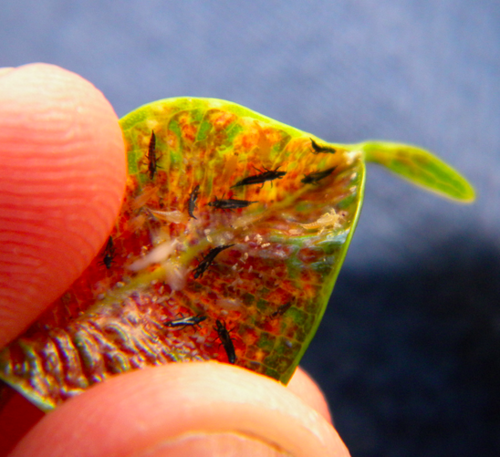
Thrips (order Thysanoptera) are very small, black or yellowish-green coloured insects with fringed wings.[1] They are also known as thunder flies, thunder bugs, storm flies, thunder blights, storm bugs, corn flies or corn lice.[2] Thrips suck, scrape and suck plant juices, stems and buds.[3]
Thrips can readily move long distances floating with the wind or transported on infested plants. For example, myoporum thrips causes severe galling of Myoporum laetumand M. pacificum. Originally from New Zealand, this thrips was introduced into Southern California. Spreading to most areas of the state where its hosts are grown.[4]
Signs of thrips on plants[edit | edit source]
Thrips tend to hide well, amid flower buds, in leaf joints, inside folded leaves and under leaves, making them harder to spot.[1] Thus, it's useful to know what to look for by way of plant damage, to alert you to their possible presence. Plants affected by thrips tend to have pale, scarred and spotted leaves/flowers/buds and the leaves may be twisted.[3][1] The petals may have brown sections or spots.[1] The plants may also die.
Thrips are attracted to blossoms or flowers that are lightly coloured, yellow or white.[3] They are poor flyers, so tend to attack one area of a plant, then spread slowly.[1]
In terms of flowers, such as dadylilies (Hemerocallis spp.), gladioli and roses are especially badly impacted by thrips. If attacked by thrips, these plants may experience so much damage that the buds fail to open.
Vegetables typically attacked by thrips include carrots, beans, squash and onions.[3]
Dealing with thrips[edit | edit source]
Spray the plant with a stream or jet of water, to remove the thrips.[1] Overhead watering can remove thrips.[1]
Remove affected parts of the plants (buds, leaves, etc.), and discard.
Aluminium foil mulch may work to confuse the thrips.[1]
Insecticidal soap made from plant oils can be used to remove thrips.[3] However, it can be hard to reach thrips, as they hide in difficult-to-reach places.[1]
Keep away the weeds and grass around desired plants, as these can serve as additional host plants attracting the thrips. Don't plant near dry and grassy areas, as these likely already host thrips.[1] Avoid pruning too much, as this stimulates new growth and this attracts thrips.[1]
Use beneficial insects that predate on thrips, such as ladybirds (ladybugs), lacewings, minute pirate bugs and effective thrips predator.[3]
Pyrethrin can be used on a severe outbreak of thrips.[3] However, this also targets beneficial insects, so should be a last resort.